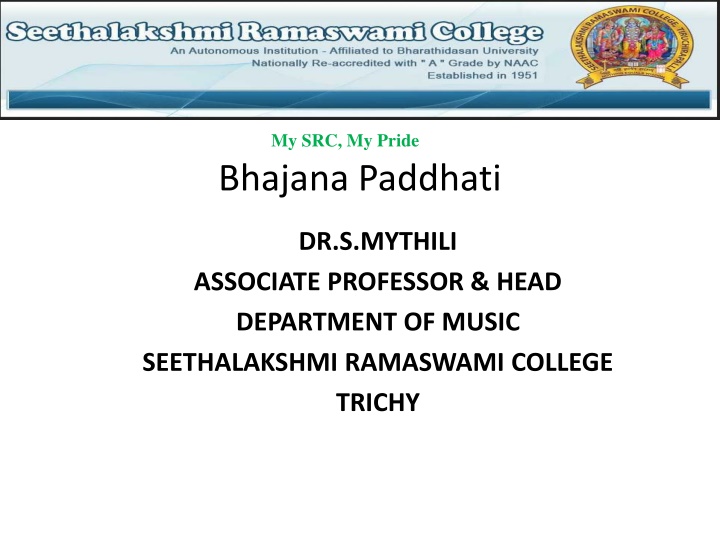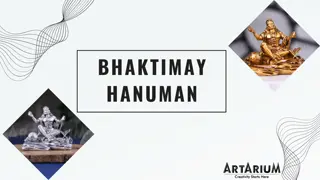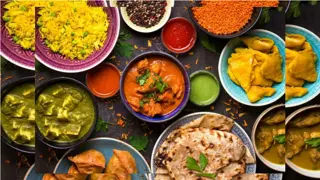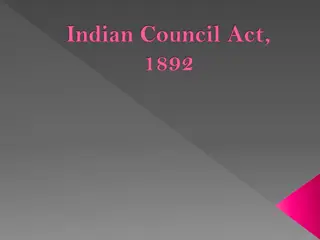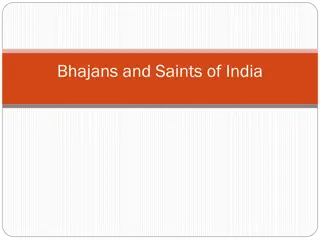The Essence of Bhajans in Indian Culture
Bhajans, a sacred musical tradition in India, are a form of devotional singing that allows individuals to focus on the divine through music and repetition of sacred names. These songs, rooted in scriptures and spiritual teachings, are usually performed in groups, creating a sense of unity and devotion. The practice of Bhajans, with its rich history and diverse forms, holds a significant place in Indian culture, providing a path for spiritual growth and connection to the divine.
Download Presentation

Please find below an Image/Link to download the presentation.
The content on the website is provided AS IS for your information and personal use only. It may not be sold, licensed, or shared on other websites without obtaining consent from the author.If you encounter any issues during the download, it is possible that the publisher has removed the file from their server.
You are allowed to download the files provided on this website for personal or commercial use, subject to the condition that they are used lawfully. All files are the property of their respective owners.
The content on the website is provided AS IS for your information and personal use only. It may not be sold, licensed, or shared on other websites without obtaining consent from the author.
E N D
Presentation Transcript
My SRC, My Pride Bhajana Paddhati DR.S.MYTHILI ASSOCIATE PROFESSOR & HEAD DEPARTMENT OF MUSIC SEETHALAKSHMI RAMASWAMI COLLEGE TRICHY
INTRODUCTION BHAJAN is derived from the word "BHAJANAM", meaning "concentrate on Naama or Roopa of God". Roopa Bhajanam requires one to sit and meditate for a long time on a figure of Ishtadaivam. This is little hard to practice, as some rules have to be followed for good results. Naama Bhajanam is repeating the name of Ishtadaivam. This is very simple and can be done throught the day and night without any effort or rules.
Added to it, if the Naama is uttered with Music (Sruti, Raaga and Thaala), it gives a soothing effect and takes the mind to "layam". It, therefore, makes it easy to get one pointed attention and at the same time, it is more pleasant to the ears of the audience, who are also attracted towards this process. It becomes a collective effort (group prayer) which is more effective. Hence, singing in praise of God is the way of life one should adopt in Kaliyuga. It is simple to follow. This should be done with concentration, Bhakthi /Devotion and with one pointed attention.
Ideas from scriptures, legendary epics, the teachings of saints and loving devotion to a deity are the typical subjects of bhajans. It is usually a group event, with one or more lead singers, accompanied with music, and sometimes dancing.Bhajans may be sung in a temple, in a home, under a tree in open, near a river bank or a place of historic significance.
Types of Bhajans A look into the past reveals that bhajans as a genre have come a long way; weaving a home for themselves into the core of human hearts. Traditions of bhajan singing, such as Nirguni, Gorakhanathi, Vallabhapanthi, Ashtachhap and Madhura-bhakti, have been formed over the ages. Each sect has their own sets of bhajans and methods of singing. The traditional form of bhajan in south india is known as Sampradya Bhajans.
Sampradaya Bhajana or Dakhshina Bharatha Sampradaya Bhajana is the tradition of Bhajans in India and as the name suggests particularly in South India. It's the collection of Kirtanas and Namavalis in specific order. Mainly the order has been evolved by Sri Marudhanallur Sadguru Swamigal, Sri Pudukottai Gopala Krishna Bhagavathar.
The trinity of gurus as far as Sampradaya Bhajans are considered as Bodhendra Swamigal, Sridhara Ayyaval and Marudhanallur Sadguru Swamigal. The sampradaya bhajana paddhati has mainly evolved due to the tradition and efforts of Marudhanallur Sadguru Swamigal
The bhajans are typically rendered in the following order: Dhyana Slokam Sangraha Thodaya Mangalam (Thotakam - Beginning with a praise, Mangalam - End)Thodaya Mangalam is different from Thotaka Ashtakam of ADI SANKARA Guru Dhyanam Guru Abhangs Sadhu Keertanas (hymns on Sadhus and sants. It can be abhangs also) Jayadeva Ashtapadi Narayana Teertha Krishna leela Tharangini
Panchapati (Five songs in Telugu (Bhadrachala Ramadas), Kannada (Sri Purandara dasa), Sanskrit (Sri Sadasiva Brahmendral), Tamil (Sri Gopalakrishna Bharati) and compositions of Sri Tyagaraja, Kabir Das, Meera Bai, Tulsi das or Surdas Marathi Abhangs on Lord Panduranga
Dyanakirtanas Now comes the turn of Dyana keertanais (hymns on Gods) 1. Vinayaka 2. Saraswati 3. Murugan 4. Shiva 5. Ambika 6. Nrusimha 7. Ram 8. Krishna 9. Vishnu or Dashavatara stuti 10. Venkatesha
11. Vittal or Pandurang (Abhangs) 12. Lakshmi 13. Sita or Radha 14. Anjaneya 15. Garuda 16. Aiyappan 17. Nandikeshwaran 18. Chandeeswaran 19. Chaitanya Mahaprabhu 20. Sri Gopalakrishna Bhagavatar (or Guru Keertanai)
Pooja Sampradaya Kritis Then comes Pooja Sampradaya Kritis 1. Baro murare (welcome) 2. Sharanagata vatsala (request) 3. Kastoori gana.. (pooja) 4. Chita juni... (aarati) 5. Shobane 6. Jay Jay aarati... 7. kanjadalakshiki.. 8. Prartana Abhang
9. Rajadi rajaya.. (pushpanjali) 10. Kattiya vachanam (verses from variety of books) 11. Chatur veda parayan 12. Kshetra mahatmiyam (verses on importance of tirta kshetras) 13. Upacharamu.. (upachara sankeertan) 14. Vinnappa gadyam (praying to God - shlokas) 15. Sri Krishna Govinda hare murare.. (naamaavali)
Deepa pradakshinam Pooja ends here and Divya namam starts.. (deepa pradakshinam - With lighted lamp in the middle considering the lamp as God, bhagavatas will do sankeertan by doing pradakshinas) This equals going around the earth. Then comes Dolotsavam(making God to sleep).Anjaneya kirtanai and Mangalam
